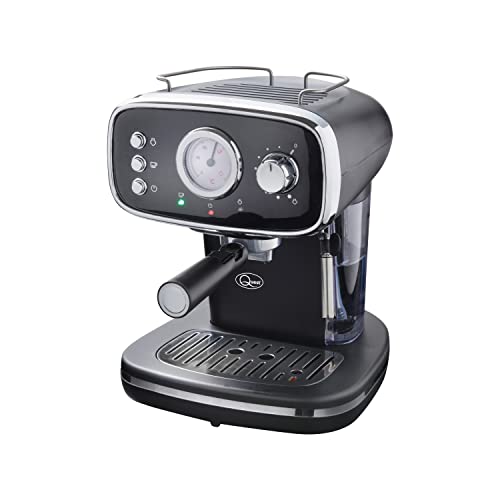How to Make Espresso Machine Coffee
Espresso machines can produce an amazing cup of coffee, however they require more maintenance and setup than a regular coffee maker. It is also necessary to grind and tamp the beans yourself.
Pressure is a key element in making espresso. How an espresso machine works is that an heating vessel heats water to a perfect temperature, then forces it out of the spouts and into the grounds.
Temperature
Espresso is made by forcing hot water through finely ground coffee. The temperature of the water is crucial to the quality of the final shot. Insufficient temperatures cause lack of flavor compounds. High temperatures can cause over extraction, which can cause bitter or burned taste.
The ideal temperature range for espresso is 195-205degF. This temperature can be achieved using a grouphead designed to maintain an unchanging temperature and stability throughout the brewing process. The E61 is the most popular group head because it offers a combination of temperature stability, pre-infusion capability and lever control.
It is important to take into account the temperature when adjusting your espresso machine for different roasts or brew ratios. This can impact the extraction yield as well as the crema. The optimal temperature will be contingent on the particular roast and bean however the general rule is that lighter roasts and higher brew ratios require higher temperatures than darker roasts and lower brew ratios. A good thermocouple is also crucial to keep an even temperature.
Pressure
When brewing, espresso machine coffee is pushed under pressure through finely ground coffee grounds that have been tamped. This causes chemical reactions to extract flavors oils, flavors, and other soluble components from the beans. The resultant beverage is usually richer and more flavorful than regular coffee.
The ideal espresso machine's pressure is nine bars of pressure, which is the same as atmospheric pressure at sea level. This is due to the fact that it's at this pressure the soluble compounds of espresso are the easiest to extract.
However some espresso machines advertise 15 or 20 bars of pressure. While these machines are able to reach these pressure levels but they might not be able to maintain the pressure level throughout the extraction.

One bar of pressure is equal to 32 pounds per square inch (PSI) of a car's tire. It's four times the pressure a professional cyclist needs to pump their bike tires. Any serious home barista must to be able manage the pressure of their espresso machine and produce consistent espressos.
Water
The water you use in your espresso machine is among the most important aspects that make a good cup coffee. The correct water will aid your beans in achieving their full potential, while the wrong water can cause issues such as blocked pipes or even harm your expensive espresso machine.
To get the most espresso extraction make sure you choose an organic spring with a high mineral content. This water will enhance the flavor of your espresso without chalky mineral traces found in tap or bottled waters. This is an excellent alternative to distilled water or reverse osmosis. This process can be too purified and cause flavor problems.
It is not recommended to utilize a water filtration device that removes too much mineral content from the water you drink. This could cause taste and extraction issues. One option is to buy a water test kit which will provide you with the average hardness of your water in your area. This can be used to locate a filtration system that will provide the proper water specifications for your espresso machine.
espresso machines uk tend to be very involved in the entire process of making espresso. They obsess over a number of variables, including temperature, pressure of water beans, milk, viscosity and other aspects. If one of the variables is not in order the whole shot may taste bad.
The beans used are the most important aspect when it comes down to espresso. People often assume that only certain types of beans work well for espresso. While some beans are appropriate for certain purposes, any roasted coffee bean can be used to make espresso. The main difference between espresso beans and regular coffee beans is that espresso beans are roasted longer, tipycally past the second crack that gives them more of a dark appearance and makes them more soluble in water.
Medium or dark roast beans are ideal for espresso because they give the shots a richness and boldness. But, it's possible to make excellent espresso using light-roasted beans, particularly when the beans are ground (for convenience in an espresso machine).
Milk
Espresso and milk are a classic combination. The combination of espresso and milk is a classic. Not only does it improve energy levels but it also balances the bitterness of the espresso. There aren't many culinary pairings better than this one!
If you decide to purchase an espresso machine that can make cappuccino or latte, be sure to consider how easy it is to use. A majority of the top espresso machines include a jug to drink hot or cold milk as well as a steam wand. They also come with a portafilter to pull the shot. Some models include a built-in grinder, tamper and frother.
The steam wand must be purged before using it for the first time every day (or after each cup of espresso) to eliminate any condensed water. This process takes about 30 seconds and is crucial to keep your machine operating smoothly. If you don't cleanse it, it could result in bitter taste and/or accumulation of bacteria that could alter the flavor or aroma of your beverage. It's not difficult to do and should be part of your routine maintenance.
